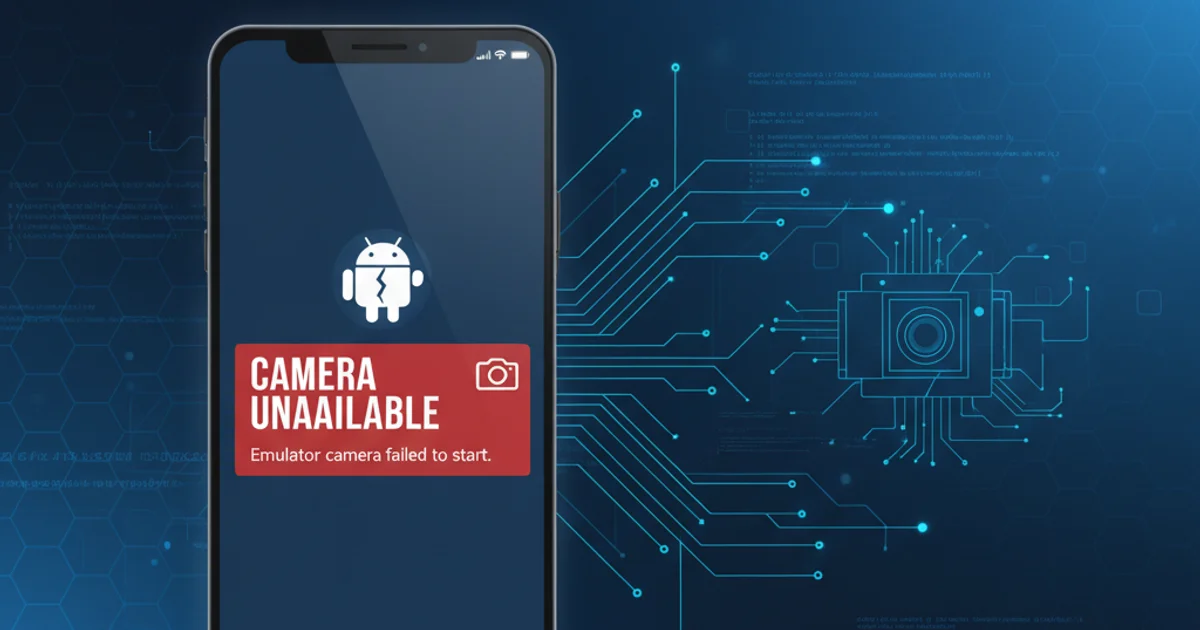Camera of any emulator not working
Categories:
Troubleshooting Android Emulator Camera Issues

Learn why your Android emulator's camera might not be working and discover effective solutions to get it up and running for app development and testing.
Developing Android applications often requires testing camera functionalities, whether it's capturing photos, recording videos, or scanning QR codes. However, it's a common frustration for developers to find that the camera within their Android emulator isn't working as expected. This article delves into the common causes behind emulator camera failures and provides a comprehensive guide to diagnose and resolve these issues, ensuring your development workflow remains smooth.
Understanding Emulator Camera Emulation
Unlike a physical device, an Android emulator doesn't have a built-in camera. Instead, it emulates camera input using various sources. These sources can include a virtual scene, a static image, or even your host machine's webcam. The configuration of these sources is crucial for the camera to function correctly within your emulated environment. Misconfigurations or missing drivers on the host system are frequent culprits.
flowchart TD
A[Start Emulator] --> B{Camera App Launched?}
B -- Yes --> C{Camera Source Configured?}
C -- Yes --> D{Host Webcam Available?}
D -- Yes --> E[Emulator Uses Host Webcam]
D -- No --> F[Emulator Uses Virtual Scene/Image]
C -- No --> G[Camera Error: No Source]
B -- No --> H[App Error: Camera Not Initialized]
G --> I[Check AVD Settings]
F --> I
E --> J[Camera Working]
H --> IFlowchart of Android Emulator Camera Initialization
Common Causes of Camera Failure
Several factors can lead to a non-functional camera in your Android emulator. Identifying the root cause is the first step towards a solution. These typically fall into categories such as AVD (Android Virtual Device) configuration, host machine issues, or even permissions within the emulated Android OS.
Troubleshooting Steps
Follow these systematic steps to diagnose and fix your emulator camera problems. We'll start with the simplest solutions and move to more complex configurations.
1. Verify AVD Camera Settings
Open Android Studio, navigate to 'Tools' > 'AVD Manager'. Edit your problematic AVD. Under 'Camera', ensure 'Front' and 'Back' are set to 'Webcam' (if you want to use your host's camera) or 'Emulated' (for a virtual scene). If 'None' is selected, the camera will not work.
2. Check Host Webcam Availability
Ensure your host machine's webcam is not in use by another application (e.g., Zoom, Skype). Only one application can typically access the webcam at a time. Close any other applications that might be using the camera.
3. Update Emulator and SDK Tools
In Android Studio, go to 'Tools' > 'SDK Manager'. Under 'SDK Tools', check for updates for 'Android Emulator' and 'Android SDK Platform-Tools'. Install any pending updates and restart Android Studio.
4. Wipe Emulator Data
Sometimes, corrupted emulator data can cause issues. In AVD Manager, click the down arrow next to your AVD and select 'Wipe Data'. This will reset the emulator to its factory state. Be aware this will delete all installed apps and data on the emulator.
5. Grant Camera Permissions
Even if the emulator camera is configured, the app itself needs permission. Launch your app on the emulator. Go to 'Settings' > 'Apps & notifications' > '[Your App]' > 'Permissions' and ensure 'Camera' permission is granted. For new apps, ensure you're requesting permissions at runtime.
6. Test with a Simple Camera Intent
To rule out issues with your specific app, try launching a simple camera intent. Create a basic Android project and use the following code snippet to launch the default camera app. If this works, the issue might be with your app's camera implementation.
import android.content.Intent;
import android.provider.MediaStore;
import androidx.appcompat.app.AppCompatActivity;
import android.os.Bundle;
import android.view.View;
import android.widget.Button;
public class MainActivity extends AppCompatActivity {
private static final int REQUEST_IMAGE_CAPTURE = 1;
@Override
protected void onCreate(Bundle savedInstanceState) {
super.onCreate(savedInstanceState);
setContentView(R.layout.activity_main);
Button launchCameraButton = findViewById(R.id.launch_camera_button);
launchCameraButton.setOnClickListener(new View.OnClickListener() {
@Override
public void onClick(View v) {
dispatchTakePictureIntent();
}
});
}
private void dispatchTakePictureIntent() {
Intent takePictureIntent = new Intent(MediaStore.ACTION_IMAGE_CAPTURE);
if (takePictureIntent.resolveActivity(getPackageManager()) != null) {
startActivityForResult(takePictureIntent, REQUEST_IMAGE_CAPTURE);
}
}
// You would typically handle the result in onActivityResult
// @Override
// protected void onActivityResult(int requestCode, int resultCode, Intent data) {
// super.onActivityResult(requestCode, resultCode, data);
// if (requestCode == REQUEST_IMAGE_CAPTURE && resultCode == RESULT_OK) {
// Bundle extras = data.getExtras();
// Bitmap imageBitmap = (Bitmap) extras.get("data");
// // Do something with the imageBitmap
// }
// }
}
Example of launching a camera intent in Java.
<?xml version="1.0" encoding="utf-8"?>
<RelativeLayout xmlns:android="http://schemas.android.com/apk/res/android"
xmlns:tools="http://schemas.android.com/tools"
android:layout_width="match_parent"
android:layout_height="match_parent"
tools:context=".MainActivity">
<Button
android:id="@+id/launch_camera_button"
android:layout_width="wrap_content"
android:layout_height="wrap_content"
android:text="Launch Camera"
android:layout_centerInParent="true"/>
</RelativeLayout>
Layout XML for the camera intent example.